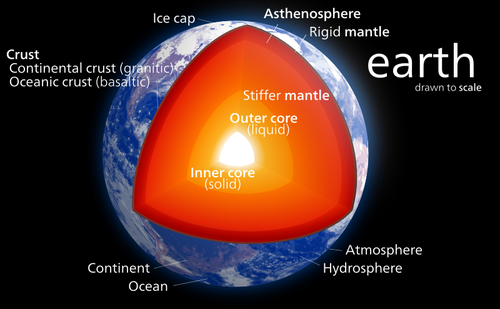Difference between revisions of "Mantle"
Jump to navigation
Jump to search
Cwhitehurst (talk | contribs) |
Cwhitehurst (talk | contribs) |
||
| Line 1: | Line 1: | ||
| − | [[File:Earth poster.svg.png]] | + | [[File:Earth poster.svg.png|thumb|500px]] |
Part of the Earth composed mainly of solid [[silicate]] rock that entends from the base of the [[crust]] to the core-mantle boundary at approximately 2900 km (-1802 mi) in depth.<ref name=Petersetal_2012>Peters, Kenneth E., David J. Curry, and Marek Kacewicz, 2012, [http://archives.datapages.com/data/specpubs/hedberg4/INTRODUCTION/INTRODUCTION.HTM An overview of basin and petroleum system modeling: Definitions and concepts], ''in'' Peters, Kenneth E., David J. Curry, and Marek Kacewicz, eds., Basin modeling: New horizons in research and applications: [http://store.aapg.org/detail.aspx?id=1106 AAPG Hedberg Series no. 4], p. 1-16.</ref> | Part of the Earth composed mainly of solid [[silicate]] rock that entends from the base of the [[crust]] to the core-mantle boundary at approximately 2900 km (-1802 mi) in depth.<ref name=Petersetal_2012>Peters, Kenneth E., David J. Curry, and Marek Kacewicz, 2012, [http://archives.datapages.com/data/specpubs/hedberg4/INTRODUCTION/INTRODUCTION.HTM An overview of basin and petroleum system modeling: Definitions and concepts], ''in'' Peters, Kenneth E., David J. Curry, and Marek Kacewicz, eds., Basin modeling: New horizons in research and applications: [http://store.aapg.org/detail.aspx?id=1106 AAPG Hedberg Series no. 4], p. 1-16.</ref> | ||
Latest revision as of 13:23, 3 August 2016
Part of the Earth composed mainly of solid silicate rock that entends from the base of the crust to the core-mantle boundary at approximately 2900 km (-1802 mi) in depth.[1]
Useful links
This article is a stub. You can help AAPG Wiki by expanding it.
References
- ↑ Peters, Kenneth E., David J. Curry, and Marek Kacewicz, 2012, An overview of basin and petroleum system modeling: Definitions and concepts, in Peters, Kenneth E., David J. Curry, and Marek Kacewicz, eds., Basin modeling: New horizons in research and applications: AAPG Hedberg Series no. 4, p. 1-16.
